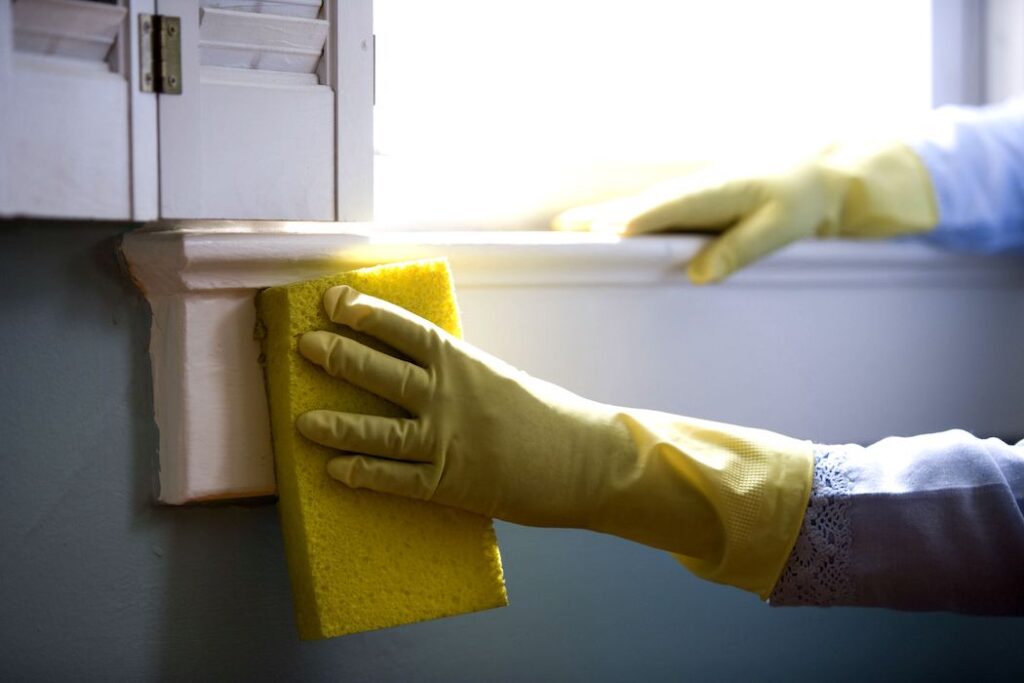What Is ‘Black Mold’ And How Do You Get Rid Of It?

Rainy season is here, which means you might be seeing or smelling some uninvited intruders, such as black mold. To paraphrase Mae West, when it’s dry in California, it’s really really dry, but when it rains it really rains. We’re in a severe drought situation, so we really need the rain, but it’s best kept outside the walls and floors of your home.
What is black mold?
Most mold is black, but when people mention black mold, they are talking about Stachybotrys chartarum (S. chartarum), also known as Stachybotrys atra. Like most in the fungi family, black mold thrives in wet environments. Black mold is especially common in basements, crawl spaces and attics, but it can also be found in bathrooms and pretty much every other room in your home. Black mold could indicate a leak from rainwater or from plumbing or from general dampness that never seems to dry.
Is black mold dangerous?
If you’ve ever watched any of the home improvement shows, there’s a lot of drama surrounding black mold. According to popular lore, black mold is about the worst thing you can find in your house. Black mold, people say, can cause a host of health problems including lung issues and even cancer. The jury is still out on it, though. Studies haven’t shown that black mold is worse than any other type of mold.
That doesn’t mean you want mold in your home. In California, you have to disclose mold to potential buyers and that can make your home much more difficult to sell. Also, some people are very sensitive to mold. If a family member suddenly exhibits asthma or allergy signs, you might want to make sure your home is clear of black mold. All molds and fungi in general can be highly toxic to someone who is severely immunocompromised.
How does black mold affect real estate prices?
Pinning down how much black mold may affect your home’s selling price is a little tough. Anecdotes claim a decrease in appraised value from 15 to nearly 50 percent. Frankly, it’s tough to see a California property selling 50 percent below comps, but it’s clear that dealing with a mold problem before selling your home will bring in higher offers.
While it is debatable whether black mold is that bad in and of itself, an abundance of black mold likely indicates a very serious problem, including a leaky roof, cracks in the foundation, leaky pipes, etc. All of these can be costly to fix and will limit the pool of potential buyers.
How to figure out if your home has black mold
Black mold can be very sneaky. It doesn’t always reveal itself, but there are ways to tell if you have black mold.
The smell test
If your home smells musty after a rain storm, or worse, all the time, there’s a good chance there’s black mold. You might be getting “nose blind” though. Meaning you are so used to the smell that you no longer recognize it. You might need to ask for some help from a friend. They will be able to detect odors you might not.
The sight test
Black mold can come in a variety of colors, including, of course, black, but also green, brown and sometimes orange with white flecks. Look for circular spots with a fuzzy look. If the infestation is especially bad, your entire wall could change color.
Signs it might be hiding
Black mold isn’t great at announcing itself, but if you see water damage in your home, there’s a good chance there’s black mold. Look for dark rings or altered textures on your walls, floors and ceilings.
How to get rid of black mold
Facing a black mold infestation, many people would prefer to hire a professional. They will likely do a thorough job, especially if it’s a large infestation, but they can be very expensive. You can do it yourself. Wear painter’s clothing, latex gloves, goggles and a face mask to avoid breathing in or taking home the mold spores. Once you’re safely dressed:
Close off the area
Mold spores, black or otherwise, will travel, so you want to seal the area off as well as you can. We recommend plastic sheeting. Open a window if possible.
Wash the area
Scrub the area with soap, water and a good scrub brush. Try to eliminate as much mold as you can.
Disinfect the area
Once the area is clean, use industrial strength vinegar, hydrogen peroxide or a diluted bleach solution. You can also buy anti-mold formulas from hardware stores.
Air it out
Once you’ve eliminated the mold, let the area completely dry and air out before replacing drywall or whatever other building materials you may need.